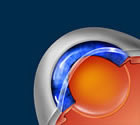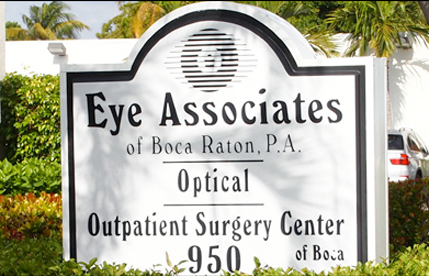Cataract Surgery
No Needle, No Stitch, No More Cataracts!
For many years most patients who underwent cataract surgery still needed to wear glasses to read. New technology now affords the patient several choices of lens implants that reduce or eliminate the need for glasses after surgery.

What are Cataracts?
Over fifty percent of people over the age of 60, and quite a few younger than that, suffer from cataracts. In fact, cataracts are so common it is said that everyone will develop a cataract if they live long enough.
A cataract is a progressive clouding of the eye’s natural lens that interferes with light passing through to the retina. Sufferers usually describe the condition as being similar to looking through a waterfall, or a piece of wax paper, with gradual blurring or dimming of vision.
Reading may become more difficult and driving a car can actually become dangerous. Cataract sufferers may also be troubled by a bothersome glare, halos around lights, or even double vision. And as the cataract becomes worse, frequent changes in eye-glass prescriptions may become necessary.
Currently there is no medical treatment to reverse or prevent the development of cataracts. Once they form, there is only one way to achieve clear vision again, and that is to physically remove the cataract from the eye.
Cataract Surgery
In your parent’s or grandparent’s day, cataract surgery was considered risky, required a lengthy hospital stay and was usually postponed for as long as possible. Today, cataract surgery is performed on out-patient basis and takes only a few minutes. Patients can then go home and rest in comfort and avoid the inconvenience and expense of staying in a hospital.
Advanced Technology Lens Implants (IOL’s)
New technology intraocular lens implants (IOL’s) used in today’s cataract surgery can reduce and in some cases eliminate your dependency upon eyeglasses following your surgery. Toric IOL’s are used to correct astigmatism that standard lens implants do not. Multifocal IOL’s provide good functional vision at distance, intermediate and near without eyeglasses. If you are presently wearing a mono-vision (one eye for near and the other for distance) correction in either your contact lenses or glasses, this can be accomplished with standard lens implants.
Lense Implants

ReZoom®
ReSTOR®
TECNIS®
Lense Implants

Crystalens®
Lense Implants

Toric
The final decision on which lens implant you choose is dependent on how you wish to see following cataract surgery and which lens options you are a candidate for. This can only be determined by your eye doctor.
Self-Sealing Incisions
Your cataract will be removed with an advanced technique called phacoemulsification, or small-incision cataract surgery. Using only a topical anesthetic, a “stair-stepped” incision of about 1/8″ is made in the sclera (white part of the eye), or in the clear cornea (just above the area where the cornea meets the sclera). The cataract is then broken into microscopic particles using high energy sound waves and gently suctioned from the eye. Then, to compensate for the removal of the eye’s natural lens, an intra-ocular lens (IOL) is implanted into the eye. After using this special “stair-stepped” incision, the eye remains tightly sealed by the natural outward pressure within your eye.
Topical Anesthesia
Topical anesthesia and self-sealing incisions have taken cataract surgery to the next level. Many patients are able to see with clear vision much sooner after the surgery. In most cases it is now possible to return to daily activities such as driving and reading almost immediately. With “eye drop” anesthesia, there is no need for a needle injection which delays vision restoration and could cause temporary swelling and skin discoloration.
Because cataract surgery can be done with just topical anesthesia, patients typically feel nothing during or after the procedure. Previously, a needle was used to inject the anesthetic. However, with all the latest advancements, including the smaller incision, we can now use eye drops to numb the eye, which means no stick of a needle before surgery. The major advantage of not having to wear a patch, besides patient comfort, is that patients can immediately see the improvement in their vision.
Successful Cataract Surgery
Everyone heals somewhat differently, but many cataract patients report improvement in their vision almost immediately after the procedure. Most patients return to their normal work and lifestyle routines within a day or two.
According to a survey conducted by the American Society of Cataract and Refractive Surgery, more than 98% of cataract patients had their vision successfully improved after surgery. Many patients experienced vision that is actually better than before they developed cataracts. Once removed, cataracts will not grow back.However, some patients may experience clouding of a thin tissue called the capsule or “bag” that holds the IOL. In most cases, a laser is used to painlessly open the clouded capsule and restore clear vision.
 Cataract Eye
Cataract Eye Cataract Removal
Cataract Removal IOL Insertion
IOL Insertion After Surgery
After Surgery











